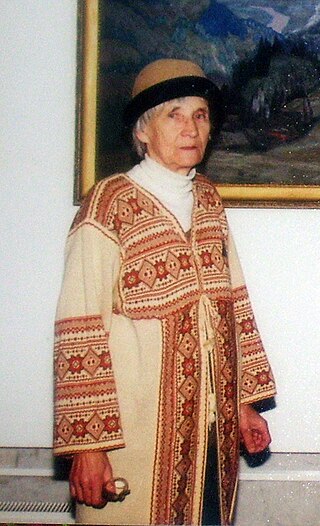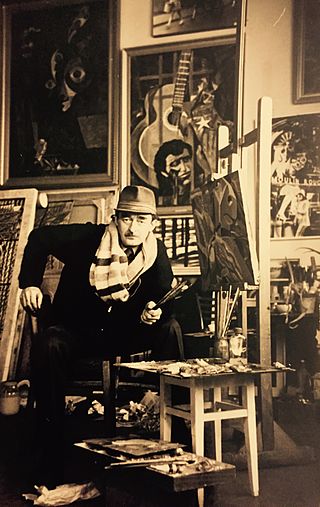
Vadym Heorhiiovych Meller was a Ukrainian and Soviet painter, avant-garde Cubist, Constructivist and Expressionist artist, theatrical designer, book illustrator, and architect. In 1925 he was awarded a gold medal for the scenic design of the Berezil Theatre in the International Exhibition of Modern Decorative and Industrial Arts in Paris.

Lybidska is the 27th station of the Kyiv Metro system that serves the Ukrainian capital Kyiv. The station was opened as part of the Obolonsko–Teremkivska Line on 30 December 1984, located in between the Palats "Ukrayina" and Demiivska stations.

Ivan Stepanovych Marchuk is a contemporary Ukrainian painter, founder of the Pliontanism technique, Honored Artist of Ukraine, laureate of the Shevchenko National Prize, Honorary Academician of the National Academy of Arts of Ukraine, Honorary Citizen of Ternopil and Kyiv.
Valeriy Marchenko was a poet, journalist, translator, and member of the Ukrainian Helsinki Group.
Mykola Storozhenko was a Ukrainian painter., author and academic.

Nikolai Bartossik is a Ukrainian-American contemporary painter and monumental artist.

Halyna Olexandrivna Zubchenko was a Ukrainian painter, muralist, social activist and member of the Club of Creative Youth. She joined the Union of Artists of Ukraine in 1965.

Karapet Yeghiazaryan was an Armenian painter, Honored Artist of Armenia, 1983.

Michael Yakovlevich Antonyuk (Russian: Михаил Яковлевич Антонюк; was a prominent honorary artist of the Republic of Kazakhstan, a monumentalist, and a member of the Union of Artists of the USSR. Regarded as an influential Avant-garde artist during the Socialist realism era, Michael Antonyuk combined elements of Cubism, Soviet avant-garde and Modernism.

Mykhailo Lvovych Boychuk was a Ukrainian monumentalist and modernist painter. He is considered a representative of the generation of the Executed Renaissance.

The National Academy of Visual Arts and Architecture is an art university in Kyiv, Ukraine specialising in visual arts and architecture. It has departments of painting, sculpture, illustration, graphic design, stage design, architecture, Art conservation, art management.

Ukrainian underground was a movement in Ukraine's Soviet period within Soviet nonconformist art from the late 1950s through the early 1990s. This art form was banned by several totalitarian countries of Eastern Europe and the USSR. It was also known under other names, such as unofficial art, nonconformist, and dissident art. It ended due to the Perestroika reform movement, which led to Ukrainian independence in 1991. After the Soviet Union collapsed, similar counter-cultural processes developed under the names of "alternative" or "marginal" art. The avant-garde ideas of underground art were picked up and developed by the next generation of the Ukrainian New Wave.
Alla Horska – was a prominent Ukrainian painter, graphic artist, and monumental artist. She was also an active representative of the Ukrainian underground and human rights movement in the 1960s. Horska persistently fought the Soviet totalitarian regime and made a major contribution to the development and preservation of Ukrainian culture and identity. She was murdered at the age of 41.

Volodymyr Volodymyrovych Melnychenko was a Ukrainian visual artist, sculptor, architect, Honored Artist of Ukraine, member of the National Union of Artists of Ukraine, member of the All-Ukrainian Creative Union "Congress of Writers of Ukraine", honorary member of the National Union of Cinematographers of Ukraine, honorary citizen of Naryan-Mar.

Vilen Isaakovych Barskyi was a Ukrainian Soviet and German painter and graphic artist. He was a member of the Union of Artists of the USSR, Dortmund Group. He was also a Russian-language poet, essayist, and author of experimental works of graphopoetry. He was a prominent representative of postmodernism, conceptualism and underground culture as well as a teacher.

The Kharkiv State Academy of Design and Arts or KSADA is a state institution of higher education in the field of Art (Design), subordinate to the Ministry of Culture and Information Policy of Ukraine and located in Kharkiv.

Teodozia Markivna Bryzh was a Ukrainian sculptor, Honored Artist of Ukraine (1997), Member of the Union of artists of the USSR.

Kyiv River Station is the main river port of Kyiv, located on the right bank of the Dnieper in Podil in the historical part of the city.
Mosaics of the River Station is a mosaic composition in the interior of the Kyiv River Station, which consists of several panels: "Dnieper - trade route," "Bogdan Khmelnytsky," "Seagulls on the Dnieper," and others.

Mykola Oleksiiovych Malyshko is a Ukrainian sculptor and teacher who became a member of the National Union of Artists of Ukraine in 1976, and a laureate of the Shevchenko National Prize.















